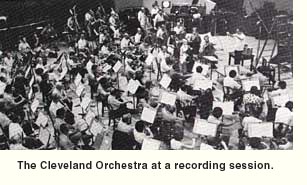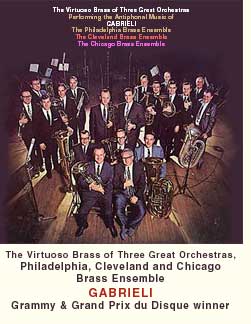RECORDINGS
 In 1969, the Cleveland Orchestra and Mr. Szell made a special series of recordings on the Angel label in addition to their CBS commitments; this affiliation produced several memorable recordings including one of Brahms’ Violin-Violincello Concerto with Davis Oistrakh and Mstislav Rostropovich.
In 1969, the Cleveland Orchestra and Mr. Szell made a special series of recordings on the Angel label in addition to their CBS commitments; this affiliation produced several memorable recordings including one of Brahms’ Violin-Violincello Concerto with Davis Oistrakh and Mstislav Rostropovich.
Bernard played the posthorn solo in a recording of Mozart’s Serenade no. 9 with members of The Cleveland Orchestra conducted by George Szell.
Louis Lane recorded with the Orchestra and also with the Cleveland Pops and the Cleveland Sinfonietta. Pierre Boulez conducted several award-winning albums in the late 1960’s and early 1970’s for Columbia Recoreds. Two of these recordings (Debussy’s Images and Stravinsky’s The Rite of Spring) were “Best Classical Performances” Grammy Award winners for 1970 and 1971, respectively.
The Cleveland Orchestra, Lorin Maazel conducting, made its first recording for London Records in the spring of 1973. The recording of Prokofiev’s ballet Romeo and Juliet was the first stereo edition of the complete work and received numerous awards including (France) Grand Prix du Disque, Best Orchestral Recording, 1973 and three Grammy nominations.
During August 1975, Lorin Maazel, The Cleveland Orchestra and Chorus, and thirteen vocal soloists recorded George Gershwin’s complete Porgy and Bess. Released on London Records in February 1976, the three-record set jumped to the number one position on Billboard Magazine popularity charts.
In January 1977, the Orchestra and Mr. Maazel made a special recording for Telarc Records of Cleveland using the direct-to-disc method, not used since the early days of the record industry. This method eliminated the intermediary step of the tape recorder and was a more efficient means of communicating the Orchestra’s “live” performance sound. Technical difficulties made this technique extremely tedious and impractical so it was eventually abandoned.
 In October 1978, Mr. Maazel and the Orchestra made a recording of Mussorgsky/Ravel’s Pictures at an Exhibition using the new digital technique. The results received wide critical acclaim, and led the Orchestra to subsequent digital recordings.
In October 1978, Mr. Maazel and the Orchestra made a recording of Mussorgsky/Ravel’s Pictures at an Exhibition using the new digital technique. The results received wide critical acclaim, and led the Orchestra to subsequent digital recordings.
Dohnanyi’s first recordings with The Cleveland Orchestra were released in 1984: Beethoven’s Third and Eighth Symphonies, and Schubert’s Unfinished. The critic of The Washington Post cited the recordings as “first-class interpretations, performed by an orchestra that is unquestionably one of the world’s greatest and presented in glowing color and impressive vitality.”
During his 28 years with The Cleveland Orchestra, Bernie remembers dozens of outstanding recordings including Strauss Alpine Symphony under Ashkenazy, Beethoven 9th under Szell and later under Dohnanyi. Two Wagner albums under Szell, Mozart Piano Concerto with Serkin under Szell, Mahler 5th under Dohnanyi as well as several albums with The Cleveland Symphonic Winds with Frederich Fermell. The list goes on and on.
One of the greatest experiences Bernard had recording was when the Cleveland brass section got together with the Chicago and Philadelphia brass sections to record the now famous record of Gabrieli canzonas which won a Grammy Award and a Grand Prix du Disque. No conductor was used. “It was a great thrill for me to play with all those marvelous brass players.”
Portions of text taken from:
“The Legacy of Bernard Adelstein” by Roger Sherman, ITG Journal, December, 1988



